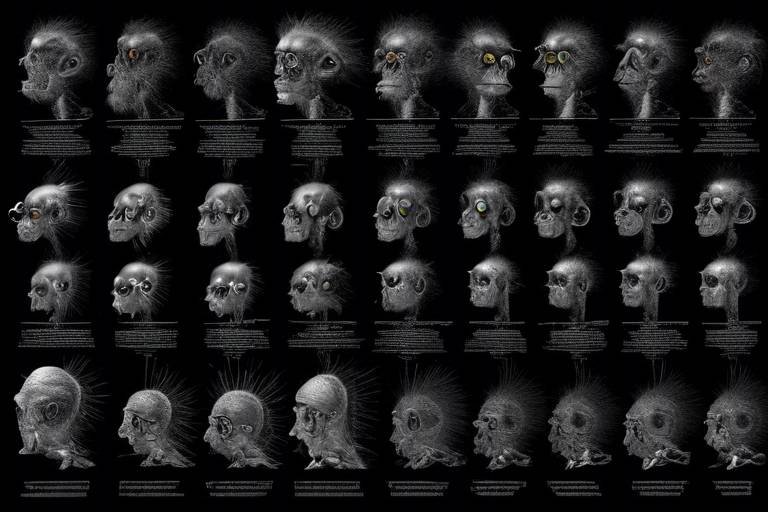Evolutionary Algorithms - The Philosophy Beneath the Science
Have you ever wondered how nature creates such complex organisms and systems? It's fascinating to think that the very principles governing evolution in the natural world can also be applied to solve computational problems. This is where evolutionary algorithms come into play. They are not just a collection of mathematical formulas; they embody a philosophy that resonates with the core of existence itself. In this article, we will delve into the foundational principles of these algorithms, explore their myriad applications, and reflect on the philosophical implications of mimicking nature within the realm of technology.
At their essence, evolutionary algorithms are inspired by the process of natural selection, where the fittest individuals are chosen for reproduction in order to produce the offspring of the next generation. This concept translates into computational problem-solving, where solutions evolve over time through mechanisms akin to selection, mutation, and crossover. Imagine a digital ecosystem where solutions compete for survival, adapting and evolving to meet the demands of their environment. This is precisely what evolutionary algorithms aim to achieve.
But why should we care about these algorithms? The truth is, they have found their way into various fields, from engineering to finance, showcasing their versatility and effectiveness in tackling complex problems that traditional methods often struggle with. Picture a financial analyst using evolutionary algorithms to optimize investment portfolios, or an engineer designing a bridge that can withstand the harshest conditions—these are just a few examples of how these algorithms are making a tangible impact in the real world.
As we embark on this journey through the world of evolutionary algorithms, we will not only uncover the technical aspects but also engage with the deeper philosophical questions they raise. What does it mean to create intelligence? Can machines truly be creative? And how do we navigate the ethical landscape when algorithms begin to influence critical decisions in our lives? These questions invite us to reflect on the role of technology in society and challenge us to think critically about the implications of our creations.
So, buckle up as we explore the remarkable intersection of science and philosophy that evolutionary algorithms represent. Whether you're a tech enthusiast, a philosopher at heart, or simply curious about the world around you, there's something here for everyone. Let's dive in!
- What are evolutionary algorithms?
Evolutionary algorithms are optimization techniques inspired by the process of natural selection, where potential solutions evolve over generations to find the best outcome.
- How do evolutionary algorithms work?
They work through processes similar to biological evolution, including selection, mutation, and crossover, allowing solutions to adapt and improve over time.
- Where are evolutionary algorithms applied?
These algorithms are used in various fields, including engineering, finance, artificial intelligence, and logistics, to solve complex optimization problems.
- What are the ethical implications of using evolutionary algorithms?
As these algorithms influence decision-making in critical areas like healthcare and finance, ethical considerations regarding bias, accountability, and transparency become paramount.

[The Basics of Evolutionary Algorithms]
Understanding the fundamentals of evolutionary algorithms is essential for grasping their role in solving complex optimization problems. At their core, these algorithms mimic the process of natural selection, where the fittest individuals are chosen for reproduction to produce the offspring of the next generation. This process involves three primary mechanisms: selection, mutation, and crossover. Each of these components plays a crucial role in evolving solutions that can adapt to changing environments and requirements.
Let’s break down these concepts a bit more:
- Selection: This is the process of choosing the best-performing candidates from the current population. Think of it as a competitive arena where only the strongest survive to pass on their genes. Various techniques, such as tournament selection or roulette wheel selection, can be employed to ensure that the most promising solutions are retained.
- Mutation: Just as genetic mutations occur in nature, introducing random changes in the algorithm can lead to new and potentially better solutions. Mutation ensures genetic diversity, preventing the algorithm from becoming stagnant and allowing it to explore new areas of the solution space.
- Crossover: This mechanism simulates reproduction, where two parent solutions combine to produce offspring. By mixing the traits of two successful candidates, the algorithm can generate new solutions that inherit the strengths of both parents. This is akin to how hybrid plants often exhibit enhanced characteristics compared to their parent species.
These three pillars work together, creating a dynamic and iterative process that gradually improves the quality of solutions over successive generations. Imagine a garden where only the most vibrant flowers are allowed to bloom, and each season, new seeds are planted, some of which are hybrid varieties that may thrive even better in their environment. This analogy captures the essence of how evolutionary algorithms operate.
Moreover, the adaptability of these algorithms is what makes them particularly appealing in various applications. They can be tailored to suit specific problems by adjusting parameters such as population size, mutation rate, and selection pressure. This flexibility allows researchers and practitioners to fine-tune their approaches, ensuring optimal performance across different scenarios.
In summary, the basics of evolutionary algorithms revolve around mimicking natural processes to solve complex problems. By leveraging the principles of selection, mutation, and crossover, these algorithms evolve solutions that are not only effective but also innovative. As we delve deeper into the applications and implications of these algorithms, it becomes clear that their potential is as vast as the natural world they seek to emulate.

[Applications in Real-World Problems]
When it comes to tackling complex challenges, evolutionary algorithms have emerged as a game-changer across various industries. Imagine trying to find the fastest route through a bustling city during rush hour; traditional methods might leave you stuck in traffic, but evolutionary algorithms can simulate countless routes, adapting and evolving to find the quickest one. This adaptability makes them incredibly valuable in fields ranging from engineering to finance.
In the world of engineering, for instance, evolutionary algorithms are utilized to optimize designs and processes. Engineers might use these algorithms to create more efficient structures or to develop innovative products that meet specific performance criteria. By mimicking the natural selection process, these algorithms can explore a vast design space, identifying solutions that traditional techniques might overlook. Think of it as a digital workshop where ideas evolve and improve over generations, leading to groundbreaking advancements.
In finance, the applications are equally impressive. Investors and analysts employ evolutionary algorithms to optimize portfolios, assess risk, and predict market trends. By analyzing historical data and simulating various investment strategies, these algorithms can adapt to changing market conditions, providing insights that help in making informed decisions. It’s like having a financial advisor that learns and grows smarter with every market fluctuation.
One of the most fascinating applications of evolutionary algorithms is in healthcare. From optimizing treatment plans to discovering new drugs, these algorithms are revolutionizing the way we approach medical challenges. For example, researchers can utilize evolutionary algorithms to model the progression of diseases, identifying potential treatment pathways that are most likely to succeed. This not only enhances patient outcomes but also streamlines the research process, making it faster and more efficient.
Moreover, in the realm of artificial intelligence, evolutionary algorithms play a crucial role in developing intelligent systems. They help in training models that can learn from data, adapt to new information, and make decisions autonomously. This is particularly evident in robotics, where evolutionary algorithms are used to evolve behaviors and strategies that enable robots to navigate complex environments or perform tasks with minimal human intervention.
To give you a clearer picture of how these algorithms are applied across different sectors, here’s a brief overview:
| Industry | Application |
|---|---|
| Engineering | Design optimization, structural analysis |
| Finance | Portfolio optimization, market prediction |
| Healthcare | Treatment planning, drug discovery |
| Artificial Intelligence | Model training, autonomous decision-making |
The versatility of evolutionary algorithms is what makes them stand out. They are not just limited to one field; rather, their principles can be adapted to solve a myriad of problems. Whether it's optimizing a supply chain, enhancing user experience in software applications, or even tackling environmental issues like climate change, the potential applications are as vast as our imagination allows.
As we continue to explore the capabilities of these algorithms, it’s essential to recognize that their effectiveness often hinges on the quality of initial conditions and parameters set by human designers. This brings us to an intriguing aspect of evolutionary algorithms: their ability to learn and adapt over time, much like organisms in nature. The blend of creativity and intelligence in these systems opens up new avenues for innovation, pushing the boundaries of what we thought was possible.
In summary, the applications of evolutionary algorithms in real-world problems are not just theoretical; they are practical, impactful, and continually evolving. As we harness their potential, we can look forward to a future where complex challenges are met with ingenious solutions, transforming industries and improving lives.
- What are evolutionary algorithms? Evolutionary algorithms are optimization techniques inspired by the process of natural selection, used to find solutions to complex problems by mimicking biological evolution.
- Where are evolutionary algorithms applied? They are applied in various fields, including engineering, finance, healthcare, and artificial intelligence, to optimize processes, designs, and decision-making.
- How do evolutionary algorithms differ from traditional methods? Unlike traditional methods that often follow a set path to find solutions, evolutionary algorithms explore multiple possibilities simultaneously, adapting and evolving over time to improve results.
- Can evolutionary algorithms be used for real-time applications? Yes, they can be adapted for real-time applications, especially in dynamic environments where conditions change rapidly, allowing systems to adjust and optimize continuously.

[Optimization Techniques]
When we think about optimization techniques in the realm of evolutionary algorithms, it's like watching nature's most brilliant strategies unfold in a digital landscape. These algorithms mimic the process of natural selection, where the best solutions to problems are not just found but evolved over time. Imagine a vast forest where only the strongest trees survive; similarly, in optimization, the most effective solutions are selected and refined through iterative processes. This approach allows for a dynamic exploration of potential solutions, often leading to outcomes that traditional methods struggle to achieve.
At the heart of these optimization techniques lies a triad of critical operations: selection, mutation, and crossover. Each operation plays a unique role in shaping the evolutionary process:
- Selection: This is akin to nature's way of choosing the fittest individuals for reproduction. In algorithms, selection involves evaluating candidate solutions based on their performance and choosing the best among them. This ensures that only the most promising solutions are carried forward to the next generation.
- Mutation: Just as genetic mutations can lead to new traits in organisms, mutation in algorithms introduces random changes to solutions. This is crucial for maintaining diversity within the population and helps avoid local optima, allowing the algorithm to explore new areas of the solution space.
- Crossover: This operation mimics biological reproduction, where two parent solutions combine to produce offspring. By exchanging information between solutions, crossover can generate new, potentially more effective solutions that inherit the strengths of their parents.
These techniques work together harmoniously, creating a cycle of evaluation, selection, and reproduction that mirrors the evolutionary processes found in nature. The result? A powerful mechanism for solving complex problems that require optimization. Whether it's finding the shortest path in a network or optimizing resource allocation in a manufacturing process, evolutionary algorithms can adapt and evolve solutions that are not only effective but also innovative.
Moreover, the beauty of these optimization techniques lies in their flexibility. They can be tailored to fit various problems across different domains. For instance, in engineering, they can optimize designs for efficiency and performance. In finance, they can help in portfolio optimization, ensuring the best investment strategies are employed. The adaptability of evolutionary algorithms makes them a go-to solution for many complex challenges.
As we delve deeper into the world of optimization techniques, it's essential to understand that the journey doesn't end with finding a solution. The iterative nature of these algorithms means that they continually refine their approaches, much like how nature itself is in a constant state of flux and adaptation. This ongoing process leads to solutions that not only meet the criteria set forth but also evolve to meet future challenges.
In conclusion, optimization techniques within evolutionary algorithms are a testament to the power of nature-inspired problem-solving. They provide a robust framework for tackling some of the most intricate challenges we face today. By embracing these techniques, we not only unlock new possibilities in computational problem-solving but also gain insights into the very essence of evolution itself.
- What are evolutionary algorithms? Evolutionary algorithms are optimization techniques that mimic the process of natural selection to solve complex problems by evolving solutions over time.
- How do selection, mutation, and crossover work in these algorithms? Selection chooses the best solutions, mutation introduces random changes, and crossover combines solutions to create new ones, all contributing to the evolution of effective solutions.
- In what fields are evolutionary algorithms applied? They are used in various fields such as engineering, finance, healthcare, and artificial intelligence, showcasing their versatility in solving real-world problems.

[Genetic Algorithms]
Genetic Algorithms (GAs) are a fascinating subset of evolutionary algorithms that draw inspiration from the principles of natural selection and genetics. Imagine a world where the strongest ideas survive and evolve, much like in nature! GAs operate on a population of potential solutions, and through a series of generations, they iteratively improve these solutions by mimicking biological processes such as selection, crossover, and mutation. This evolutionary process leads to the emergence of highly optimized solutions for complex problems.
At the heart of Genetic Algorithms is the concept of fitness. Each solution in the population is evaluated based on how well it solves the problem at hand, akin to how animals with better traits survive in nature. The solutions that are deemed fit are more likely to be selected for reproduction, while the less fit solutions are gradually eliminated from the population. This selection process not only ensures that the best solutions are carried forward but also introduces a level of diversity that is crucial for finding optimal solutions.
Once the selection is complete, the next step involves crossover, where two parent solutions combine their features to produce offspring. Think of it as mixing two different colors of paint to create a new shade! This process encourages the exploration of new solution spaces and helps prevent stagnation in the search for optimal solutions. Following crossover, mutation introduces random changes to some offspring, akin to genetic mutations in nature. This randomness can lead to unexpected and innovative solutions, ensuring that the algorithm does not get trapped in local optima.
To give you a clearer picture, let’s break down the key components of Genetic Algorithms in the table below:
| Component | Description |
|---|---|
| Population | A set of potential solutions to the problem. |
| Fitness Function | A measure of how well each solution solves the problem. |
| Selection | The process of choosing the best solutions for reproduction. |
| Crossover | The combination of two parent solutions to create offspring. |
| Mutation | A random alteration of offspring to introduce diversity. |
Genetic Algorithms have found applications in various fields, including engineering design, scheduling problems, and even game development. The beauty of GAs lies in their ability to adapt and evolve solutions over time, making them a powerful tool for tackling complex optimization challenges. However, like any tool, they are not without their limitations. The performance of GAs can be influenced by the choice of parameters such as population size, mutation rate, and selection pressure, making the tuning of these parameters a crucial aspect of the algorithm's success.
As we delve deeper into the world of Genetic Algorithms, we uncover not just a method of problem-solving, but a reflection of the intricate dance of life itself. The interplay of selection, crossover, and mutation mirrors the very essence of evolution, prompting us to ponder the implications of such powerful algorithms in our technology-driven society. Will they lead us towards smarter solutions, or will they challenge our understanding of creativity and intelligence? The journey of discovery continues!
- What are Genetic Algorithms used for? Genetic Algorithms are used for optimization problems across various fields such as engineering, finance, and artificial intelligence.
- How do Genetic Algorithms differ from traditional algorithms? Unlike traditional algorithms that follow a set procedure, Genetic Algorithms evolve solutions through a process that mimics natural selection.
- Can Genetic Algorithms guarantee the best solution? While they are powerful, GAs do not guarantee the absolute best solution; they are designed to find good solutions within a reasonable timeframe.
- What is a fitness function? A fitness function is a specific measure used to evaluate how well a solution solves the problem at hand.

[Differential Evolution]
Differential Evolution (DE) is not just another optimization technique; it's a powerful method that has revolutionized how we tackle real-valued optimization problems. Imagine you’re navigating through a dense forest—each twist and turn represents a potential solution. Now, think of DE as a group of skilled hikers who, through collaboration and a bit of trial and error, find the best path to the summit. This technique stands out because it operates on the principle of **mutation** and **crossover**, reminiscent of evolutionary processes in nature. By leveraging the differences among potential solutions, DE intelligently explores the solution space, ensuring that it doesn’t just stumble upon a good solution but rather evolves towards the best one.
At its core, DE utilizes a simple yet effective algorithmic structure that can be summarized in three main steps:
- Mutation: This step involves creating a new solution by adding the weighted difference between two randomly selected solutions to a third solution. This is akin to introducing diversity in a gene pool, which is crucial for evolution.
- Crossover: Here, the algorithm combines the mutated solution with the original solution to create a new candidate. This is similar to how traits are blended in offspring, allowing for the exploration of new possibilities.
- Selection: Finally, the algorithm evaluates the new candidate solutions against the existing ones, keeping the one that offers the best fitness. This mirrors the natural selection process where only the fittest survive.
One of the most remarkable features of Differential Evolution is its **simplicity** and **ease of implementation**. Unlike other optimization algorithms that may require complex mathematical formulations, DE can be applied with minimal tuning, making it accessible for both novices and experts alike. This accessibility has led to its adoption across various fields, including engineering, robotics, and even finance, where the need for efficient and effective optimization solutions is paramount.
Moreover, DE has demonstrated its robustness in handling multi-modal optimization problems—those pesky situations where there are multiple optimal solutions. Think of it as a treasure hunt where there are several hidden treasures scattered across the landscape. DE’s ability to explore multiple regions of the solution space simultaneously allows it to discover various solutions, providing a more comprehensive understanding of the problem at hand.
In conclusion, Differential Evolution is more than just an optimization technique; it embodies the essence of evolution itself. By mimicking natural processes, DE not only finds solutions but also enhances our understanding of how complex systems can be navigated. As we continue to explore this fascinating field, the potential applications seem limitless, from optimizing engineering designs to solving intricate problems in artificial intelligence.

[Swarm Intelligence]
Swarm intelligence is a fascinating concept that draws inspiration from the collective behavior observed in nature. Think of a flock of birds flying in perfect formation or a school of fish darting through the water in unison. These natural phenomena are not just beautiful; they embody the essence of cooperation and coordination, leading to efficient problem-solving without a central control system. In the realm of computational algorithms, swarm intelligence mimics these natural systems, creating robust solutions to complex problems that would otherwise baffle traditional methods.
At its core, swarm intelligence is about the power of collaboration. Just as individual birds or fish contribute to the group's overall efficiency, individual agents in a swarm algorithm work together to find optimal solutions. This decentralized approach allows for adaptability and resilience, as each agent can respond to its environment and the actions of others. For example, in Particle Swarm Optimization (PSO), each "particle" represents a potential solution that explores the solution space, sharing information with neighboring particles to enhance their search for the best solution. This is akin to how a group of birds communicates through subtle movements and changes in direction.
The beauty of swarm intelligence lies in its simplicity and effectiveness. By harnessing the collective behavior of simple agents, complex problems can be tackled with surprising efficiency. These algorithms have found applications in various fields, including robotics, data mining, and network optimization. For instance, in logistics, swarm algorithms can optimize delivery routes by simulating how ants find the shortest path to food sources. The ants’ ability to communicate and adapt to changing environments serves as a powerful model for solving real-world problems.
Moreover, swarm intelligence encourages a shift in mindset from individualism to collaboration. In our increasingly interconnected world, this philosophy resonates deeply. We see the potential of swarm intelligence not only in technology but also in social systems. Just as swarms in nature thrive on cooperation, communities can leverage collective intelligence to address challenges, innovate, and create solutions that benefit everyone. This interconnectedness can lead to more sustainable and effective problem-solving strategies.
As we delve deeper into the implications of swarm intelligence, it becomes evident that it challenges traditional notions of intelligence and creativity. It raises questions about how we define success and innovation. Is it the brilliance of a single mind, or is it the synergy of many? This philosophical inquiry is vital as we integrate more intelligent systems into our lives, prompting us to rethink our relationship with technology and each other.
In conclusion, swarm intelligence is not just a scientific concept; it's a reflection of nature's wisdom. By studying and applying these principles, we can unlock new potentials in optimization and problem-solving. As we continue to explore the intersection of technology and natural processes, the lessons learned from swarm intelligence will undoubtedly shape the future of computational algorithms and their applications in our society.
- What is swarm intelligence? Swarm intelligence is a concept that mimics the collective behavior of natural systems, such as flocks of birds or schools of fish, to solve complex problems through decentralized cooperation.
- How does swarm intelligence apply to algorithms? Swarm intelligence algorithms, like Particle Swarm Optimization, use multiple agents that communicate and collaborate to explore solution spaces, leading to efficient problem-solving.
- What are some applications of swarm intelligence? Swarm intelligence is used in various fields, including logistics for route optimization, robotics for coordinated movement, and data mining for pattern recognition.
- Why is swarm intelligence important? It emphasizes collaboration over individualism, reflecting how interconnected systems can lead to innovative solutions, which is increasingly relevant in our technology-driven world.

[Philosophical Implications]
The realm of evolutionary algorithms extends far beyond mere computational efficiency; it delves into profound philosophical questions that challenge our understanding of intelligence, creativity, and the essence of problem-solving. By mimicking the processes of natural selection, these algorithms compel us to reconsider what it means to be intelligent. Are machines capable of creativity, or are they simply executing predefined algorithms? This question echoes the age-old debate about the nature of intelligence itself. Just as humans evolve through experience and adaptation, can we say that machines, through their iterative processes, are also evolving?
Moreover, the philosophical implications of evolutionary algorithms prompt us to reflect on the role of technology in our society. As these algorithms become more integrated into decision-making processes, particularly in sensitive areas like healthcare and finance, we must ask ourselves: What ethical responsibilities do we have as creators of these systems? When an algorithm makes a decision that affects human lives, who is accountable? The programmer? The machine? Or the society that allows such systems to operate?
To illustrate the complexity of these issues, consider the following table that outlines key philosophical questions associated with evolutionary algorithms:
| Philosophical Question | Description |
|---|---|
| Intelligence | What constitutes intelligence in machines versus humans? |
| Creativity | Can machines genuinely create, or do they merely recombine existing ideas? |
| Accountability | Who is responsible for the outcomes of algorithm-driven decisions? |
| Ethics | What ethical guidelines should govern the use of evolutionary algorithms? |
As we explore the relationship between nature and nurture in algorithms, we find ourselves confronted with the age-old debate about the influence of initial conditions versus evolutionary processes. In human development, both genetics and environment shape who we become. Similarly, in evolutionary algorithms, the initial parameters set by developers can significantly influence the outcomes. This raises the question: Are the results of these algorithms a product of their design, or do they evolve independently?
In the context of ethical considerations, we must also ponder the implications of deploying evolutionary algorithms in autonomous systems. For example, if an algorithm governing a self-driving car makes a decision that leads to an accident, how do we assign blame? These questions are not just theoretical; they have real-world consequences that require careful consideration. As we navigate the complexities of these technologies, it is crucial to establish ethical frameworks that guide their development and deployment.
In conclusion, the philosophical implications of evolutionary algorithms are as intricate as the algorithms themselves. They challenge us to think critically about intelligence, creativity, and accountability in a world increasingly influenced by technology. As we continue to innovate and integrate these systems into our lives, the dialogue surrounding these philosophical questions will only grow in importance.
- What are evolutionary algorithms? Evolutionary algorithms are optimization techniques inspired by natural selection, which iteratively evolve solutions to complex problems.
- How do evolutionary algorithms differ from traditional algorithms? Unlike traditional algorithms that follow a set path to find a solution, evolutionary algorithms explore multiple solutions simultaneously, adapting over time.
- What are the ethical concerns surrounding evolutionary algorithms? Ethical concerns include accountability for decisions made by algorithms, potential biases in decision-making, and the impact on employment and society.
- Can machines exhibit creativity through evolutionary algorithms? While machines can generate novel solutions, whether this constitutes true creativity is a subject of ongoing philosophical debate.

[Nature vs. Nurture in Algorithms]
When we dive into the world of evolutionary algorithms, the debate of nature versus nurture takes on a fascinating twist. Just like in human development, where genetic predispositions (nature) and environmental influences (nurture) shape who we are, evolutionary algorithms grapple with similar concepts. In the context of algorithms, nature represents the inherent design and initial conditions of the algorithm, while nurture embodies the iterative processes and adaptations the algorithm undergoes as it interacts with its environment.
At first glance, it might seem that the performance of an algorithm is solely determined by its initial setup. However, as we dig deeper, we find that the evolutionary process—akin to the nurturing aspect—plays a crucial role in refining and optimizing solutions. For instance, consider a genetic algorithm tasked with solving a complex optimization problem. The initial population of solutions (nature) might be diverse, but it's the selection, mutation, and crossover processes (nurture) that truly drive the evolution of superior solutions over generations.
To illustrate this point further, let's break down the elements involved:
- Initial Conditions (Nature): The starting point of the algorithm, which includes parameters like population size, mutation rates, and selection methods.
- Evolutionary Processes (Nurture): The dynamic adjustments made to the algorithm based on performance feedback, allowing it to adapt and improve over time.
In essence, while the foundational setup of an evolutionary algorithm lays the groundwork, it is the ongoing interactions and adaptations that lead to success. This duality raises intriguing questions about the balance between initial conditions and evolutionary processes. Are we witnessing the power of natural selection in a computational realm, or is it the careful nurturing of solutions that ultimately defines success?
Moreover, this discussion invites us to reflect on the broader implications of these algorithms in real-world applications. In fields such as healthcare or finance, where decisions can have profound impacts, understanding the balance between nature and nurture in algorithm performance is crucial. It encourages developers and researchers to consider not just how they set up their algorithms, but also how they allow them to evolve. This understanding can lead to more effective and ethical implementations of evolutionary algorithms, ensuring that they serve society in a responsible manner.
As we continue exploring this captivating intersection of philosophy and technology, we find ourselves asking: Can we truly replicate the complexity of natural evolution in our algorithms? The answer is a resounding yes, but it requires a delicate balance between the inherent design of the algorithms and the nurturing processes that guide their evolution.

[Ethical Considerations]
When we delve into the world of evolutionary algorithms, it’s essential to consider the ethical implications that arise from their use. These algorithms, which mimic natural selection, can yield incredible results in various domains, but their application often raises significant moral questions. For instance, in fields like healthcare and finance, decisions made by these algorithms can profoundly affect lives and livelihoods. The question is: how do we ensure that these systems are used responsibly?
One of the primary concerns is the potential for bias. Algorithms are only as good as the data they are trained on, and if that data contains biases, the algorithm will likely perpetuate them. For example, if a healthcare algorithm is trained on data that predominantly represents one demographic, it may lead to inadequate or harmful recommendations for underrepresented groups. This raises the ethical dilemma of fairness and equity in algorithmic decision-making.
Moreover, the transparency of these algorithms is another critical issue. Many evolutionary algorithms operate as "black boxes," meaning their decision-making processes are not easily understood by humans. This lack of transparency can lead to a trust deficit among users and stakeholders. How can we hold these systems accountable if we cannot comprehend how they arrive at their conclusions?
In addition to bias and transparency, there are also concerns regarding autonomy. As we increasingly rely on evolutionary algorithms for critical decision-making, we risk undermining human agency. For instance, in autonomous vehicles, algorithms must make split-second decisions that could mean the difference between life and death. The ethical question here is: who is responsible for the decisions made by these algorithms? Is it the developers, the users, or the algorithms themselves?
To navigate these ethical waters, it is vital to establish guidelines and frameworks that govern the use of evolutionary algorithms. This could include:
- Regular audits of algorithms to ensure they are functioning as intended and not perpetuating bias.
- Transparency initiatives that allow users to understand how algorithms make decisions.
- Human oversight in critical applications to maintain a balance between algorithmic efficiency and human ethics.
As we continue to integrate evolutionary algorithms into various sectors, it’s crucial to engage in ongoing discussions about their ethical implications. This involves not only technologists and data scientists but also ethicists, policymakers, and the general public. By fostering a multidisciplinary dialogue, we can work towards ensuring that these powerful tools are used for the greater good, minimizing harm while maximizing their potential benefits.
Q1: What are evolutionary algorithms?
Evolutionary algorithms are optimization techniques inspired by the process of natural selection. They use mechanisms such as selection, mutation, and crossover to evolve solutions to complex problems.
Q2: How do evolutionary algorithms differ from traditional algorithms?
Unlike traditional algorithms that follow a fixed set of rules, evolutionary algorithms adapt and improve over time based on feedback from their environment, making them particularly effective for solving complex, nonlinear problems.
Q3: What are some common applications of evolutionary algorithms?
Evolutionary algorithms are widely used in fields such as engineering, finance, robotics, and artificial intelligence, where they help optimize solutions and improve decision-making processes.
Q4: Are there any risks associated with using evolutionary algorithms?
Yes, there are potential risks, including algorithmic bias, lack of transparency, and ethical dilemmas regarding autonomy and responsibility in decision-making.
Frequently Asked Questions
- What are evolutionary algorithms?
Evolutionary algorithms are computational methods inspired by the process of natural selection. They mimic biological evolution to solve optimization and search problems by iteratively selecting, mutating, and recombining solutions.
- How do evolutionary algorithms work?
These algorithms work by creating a population of potential solutions and applying evolutionary operators like selection, crossover, and mutation. Over generations, the population evolves, improving the solutions based on a defined fitness function.
- What are some common applications of evolutionary algorithms?
Evolutionary algorithms are used in various fields such as engineering, finance, and artificial intelligence. They are particularly effective in solving complex problems like optimization tasks, scheduling, and design issues.
- What is the difference between genetic algorithms and differential evolution?
Genetic algorithms focus on simulating biological evolution through selection, crossover, and mutation of binary strings. In contrast, differential evolution is a more recent technique that optimizes real-valued parameters by using differences between solution vectors.
- How do swarm intelligence and evolutionary algorithms relate?
Swarm intelligence refers to the collective behavior of decentralized systems, such as flocks of birds or ant colonies. Evolutionary algorithms can incorporate principles from swarm intelligence to enhance problem-solving strategies through collaborative behaviors.
- What philosophical questions do evolutionary algorithms raise?
These algorithms prompt discussions about the nature of intelligence and creativity in artificial systems. They challenge our understanding of problem-solving and the role of technology in society, asking whether machines can truly "think" or "create" like humans.
- Are there ethical concerns associated with evolutionary algorithms?
Yes, there are significant ethical considerations, especially when these algorithms influence critical areas like healthcare and finance. The potential for biased outcomes or unintended consequences raises questions about accountability and the ethical use of technology.
- How do initial conditions affect the performance of evolutionary algorithms?
The debate on nature vs. nurture in algorithms suggests that both initial conditions and evolutionary processes play crucial roles in performance. A well-designed initial population can significantly impact the algorithm's ability to find optimal solutions.



















